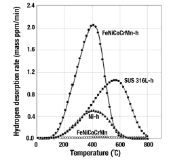Hydrogen embrittlement in compositionally complex FeNiCoCrMn FCC solid solution alloy
Abstract
The influence of internal hydrogen on the tensile properties of an equi-molar FeNiCoCrMn alloy results in a significant reduction of ductility, which is accompanied by a change in the fracture mode from ductile microvoid coalescence to intergranular failure. The introduction of 146.9 mass ppm of hydrogen reduced the plastic strain to failure from 0.67 in the uncharged case to 0.34 and 0.51 in hydrogen-charged specimens. This reduction in ductility and the transition in failure mode are clear indications that this alloy exhibits the classic signs of being susceptible to hydrogen embrittlement. The results are discussed in terms of the hydrogen-enhanced plasticity mechanism and its influence on hydrogen-induced intergranular failure. Furthermore, a new additional constraint that further promotes intergranular failure is introduced for the first time.
- Authors:
-
- Univ. of Wisconsin, Madison, WI (United States). Dept. of Engineering Physics
- Univ. of Illinois, Urbana, IL (United States). Dept. of Materials Science and Engineering; Kyushu Univ. (Japan). International Inst. for Carbon-Neutral Energy Research
- Oak Ridge National Lab. (ORNL), Oak Ridge, TN (United States). Materials Science & Technology Division
- Kyushu Univ. (Japan). International Inst. for Carbon-Neutral Energy Research; JFE Holdings, Inc., Tokyo (Japan). Steel Research Lab.,Materials Surface and Interface Science Research Dept.
- Univ. of Wisconsin, Madison, WI (United States). Dept. of Engineering Physics and Dept. of Materials Science and Engineering; Kyushu Univ. (Japan). International Inst. for Carbon-Neutral Energy Research
- Publication Date:
- Research Org.:
- Oak Ridge National Lab. (ORNL), Oak Ridge, TN (United States)
- Sponsoring Org.:
- USDOE Office of Science (SC), Basic Energy Sciences (BES) (SC-22). Materials Sciences & Engineering Division; National Science Foundation (NSF); JFE Holdings, Inc., Tokyo (Japan); Ministry of Education, Culture, Sports, Science and Technology (MEXT); Kyushu Univ. (Japan); Univ. of Wisconsin, Madison, WI (United States); USDOE
- OSTI Identifier:
- 1427650
- Alternate Identifier(s):
- OSTI ID: 1703712
- Grant/Contract Number:
- AC05-00OR22725; CMMI-1406462; DMR-1121288
- Resource Type:
- Accepted Manuscript
- Journal Name:
- Current Opinion in Solid State and Materials Science
- Additional Journal Information:
- Journal Volume: 22; Journal Issue: 1; Journal ID: ISSN 1359-0286
- Publisher:
- Elsevier
- Country of Publication:
- United States
- Language:
- English
- Subject:
- 36 MATERIALS SCIENCE; 71 CLASSICAL AND QUANTUM MECHANICS, GENERAL PHYSICS; High entropy alloy; Hydrogen embrittlement; Mechanical properties; Grain boundaries
Citation Formats
Nygren, K. E., Bertsch, K. M., Wang, S., Bei, H., Nagao, A., and Robertson, I. M. Hydrogen embrittlement in compositionally complex FeNiCoCrMn FCC solid solution alloy. United States: N. p., 2018.
Web. doi:10.1016/j.cossms.2017.11.002.
Nygren, K. E., Bertsch, K. M., Wang, S., Bei, H., Nagao, A., & Robertson, I. M. Hydrogen embrittlement in compositionally complex FeNiCoCrMn FCC solid solution alloy. United States. https://doi.org/10.1016/j.cossms.2017.11.002
Nygren, K. E., Bertsch, K. M., Wang, S., Bei, H., Nagao, A., and Robertson, I. M. Thu .
"Hydrogen embrittlement in compositionally complex FeNiCoCrMn FCC solid solution alloy". United States. https://doi.org/10.1016/j.cossms.2017.11.002. https://www.osti.gov/servlets/purl/1427650.
@article{osti_1427650,
title = {Hydrogen embrittlement in compositionally complex FeNiCoCrMn FCC solid solution alloy},
author = {Nygren, K. E. and Bertsch, K. M. and Wang, S. and Bei, H. and Nagao, A. and Robertson, I. M.},
abstractNote = {The influence of internal hydrogen on the tensile properties of an equi-molar FeNiCoCrMn alloy results in a significant reduction of ductility, which is accompanied by a change in the fracture mode from ductile microvoid coalescence to intergranular failure. The introduction of 146.9 mass ppm of hydrogen reduced the plastic strain to failure from 0.67 in the uncharged case to 0.34 and 0.51 in hydrogen-charged specimens. This reduction in ductility and the transition in failure mode are clear indications that this alloy exhibits the classic signs of being susceptible to hydrogen embrittlement. The results are discussed in terms of the hydrogen-enhanced plasticity mechanism and its influence on hydrogen-induced intergranular failure. Furthermore, a new additional constraint that further promotes intergranular failure is introduced for the first time.},
doi = {10.1016/j.cossms.2017.11.002},
journal = {Current Opinion in Solid State and Materials Science},
number = 1,
volume = 22,
place = {United States},
year = {Thu Feb 01 00:00:00 EST 2018},
month = {Thu Feb 01 00:00:00 EST 2018}
}
Web of Science
Figures / Tables:
 Figure 1: Thermal desorption analysis spectra of the uncharged and hydrogen-charged FeNiCoCrMn alloy; heating rate = 200 ºC/h. Data for Ni and SUS316L austenitic stainless steel (heating rate = 200 ºC/h) are included for comparison. ● HC1; ○ uncharged; ▲ Ni; ■ SUS 316 L austenitic stainless steel.
Figure 1: Thermal desorption analysis spectra of the uncharged and hydrogen-charged FeNiCoCrMn alloy; heating rate = 200 ºC/h. Data for Ni and SUS316L austenitic stainless steel (heating rate = 200 ºC/h) are included for comparison. ● HC1; ○ uncharged; ▲ Ni; ■ SUS 316 L austenitic stainless steel.
Figures / Tables found in this record:

 Search WorldCat to find libraries that may hold this journal
Search WorldCat to find libraries that may hold this journal